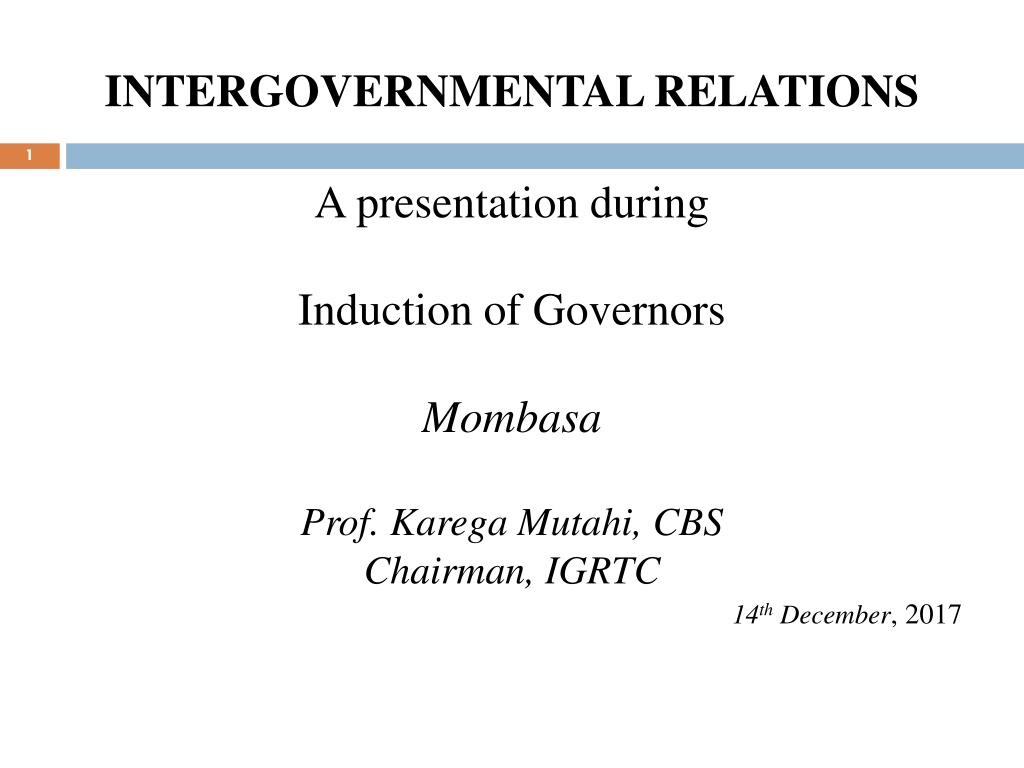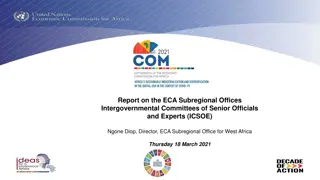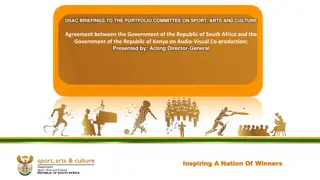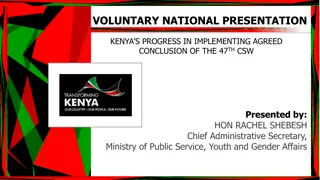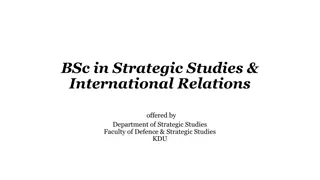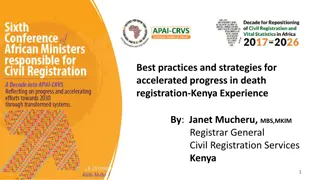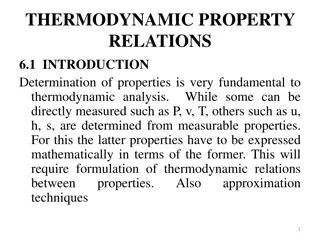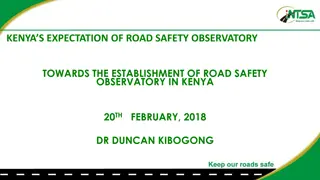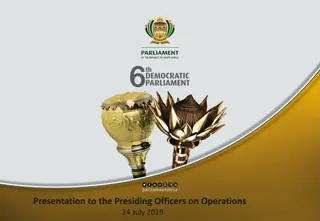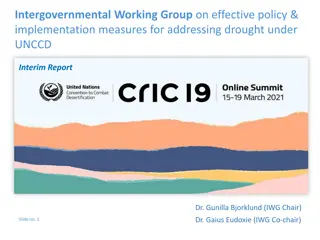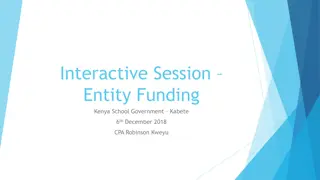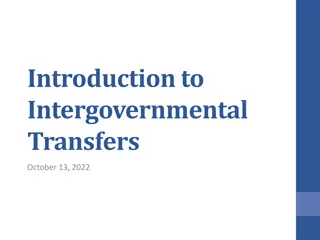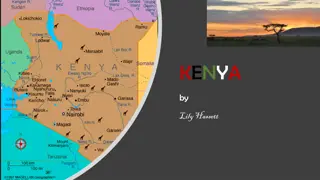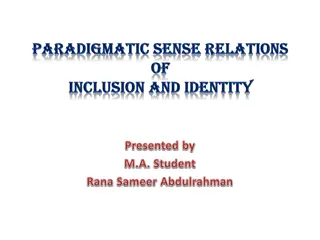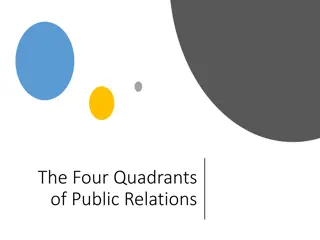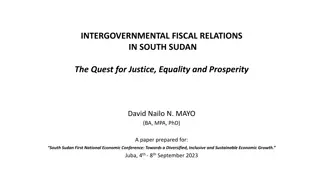Understanding Intergovernmental Relations in Kenya
Intergovernmental Relations (IGR) in Kenya involve interactions between government entities within a decentralized system. This presentation outlines the institutional framework, disputes, progress of audits, and assets/liabilities in IGR. It emphasizes the importance of statutory and non-statutory evolution in maintaining cordial relations. Key statutory institutions supporting IGR implementation include the National & County Governments Coordinating Summit, Council of Governors, and Intergovernmental Relations Technical Committee.
Download Presentation

Please find below an Image/Link to download the presentation.
The content on the website is provided AS IS for your information and personal use only. It may not be sold, licensed, or shared on other websites without obtaining consent from the author. Download presentation by click this link. If you encounter any issues during the download, it is possible that the publisher has removed the file from their server.
E N D
Presentation Transcript
INTERGOVERNMENTAL RELATIONS 1 A presentation during Induction of Governors Mombasa Prof. Karega Mutahi, CBS Chairman, IGRTC 14thDecember, 2017
PRESENTATION OUTLINE 2 INTRODUCTION INSTITUTIONAL FRAMEWORK INTERGOVERNMENTAL RELATIONS DISPUTES PROGRESS OF AUDIT OF ASSETS & LIABILITIES CONCLUSION 1) 2) 3) 4) 5)
1. INTRODUCTION 3 Intergovernmental Relations (IGR) is defined as: Interactions between & among gov ts within a decentralized system It is a natural creature of devolved or federal system, upholds two levels in the governance structure: Self rule & Shared Rule May be thro Statutory or Non-statutory evolution Statutory thro constitution, legislation or both (like Case for Kenya: CoK, 2010 & legislations)
Intro 4 Non-Statutory evolution thro practice & tradition caused by existential threat/need within the realm of power games & drive to coexist in unity of purpose Examples: County Assembly Forum, Society of Clerks at the Table (SOCATT), County Attorneys Forum among others The forums might eventually mutate into statutory institutions thro legislation
2. INSTITUTIONAL FRAMEWORK 5 Foundation of IGR in Kenya: a) CoK; articles.1, 6, 174, 186, 187, & 189. b) Legislation; CG Act,2012, IGR Act, 2012 & PFM Act, 2012, UA&C. Act, 2012 Basis for cordial relations in IGR in Kenya: Distinctness, Interdependence & Respect for the mandate & Institutions of either level Obligation to work with each other thro Consultation, Cooperation & Coordination
Framework 6 The failure to adhere to the foundational provisions (Art.1, 6, & 189; and IGRA,2012, CGA, 2012, PFM, 2012, UA&CA, 2012) can create conflicts, competition & disputes Statutory Institutions supporting implementation of IGR: National & County Governments Coordinating Summit (IGR Act, 2012 s.7) Council of Governors (IGR Act, 2012 s.19) Intergovernmental Relations Technical committee (IGR Act, 2012 s.11)
Framework 7 Intergovernmental Budget & Economic Council (PFM Act, 2012 s.187) County Intergovernmental Forum (CG Act, 2012 s.54 Sectoral Forums (IGR Act, 2012 s.13) Joint Intergovernmental Technical Committee (PFM Act, 2012 s.100)
3. INTERGOVERNMENTAL RELATIONS IN KENYA 8 Functional Intergovernmental Relations (IGR) in Kenya is founded in CoK 2012 Articles 6 and 189. Article 6(2) defines the governments at national and county levels as distinct and interdependent. The two levels of government are required to conduct their mutual relations based on consultation and cooperation. Article 189 (a) requires the two levels of government to perform their functions and exercise powers in a manner that respects the functional and institutional integrity of the government and the other level.
IGR in Kenya 9 Each level of government is required to respect the constitutional status and the institutions of government at the other level. The same requirement applies to the relationships amongst county governments. Based on the above, a number of intergovernmental relations institutions were established to facilitate cooperative governance in Kenya. Key among these are the Summit, the CoG, IGRTC, IBEC, Sector Forums and the County Intergovernmental Forum. These are the institutions that are mandated to bring the different governments together for consultation., cooperation and coordination of service delivery.
4. EXPERIENCE OVER THE FIRST FIVE (5) YEARS 10 While there have been challenges emerging from the interactions between the two levels of government, Kenya has done extremely well given her choice to effect devolution with one bang i.e. in one day. The products of devolution are spread across the entire nation. The intergovernmental relations institutions mentioned above and in particular the Summit, CoG, IBEC and IGRTC have all played their parts in facilitating cordial intergovernmental relations. As a result, there has been no failure or suspension of a county government which is a commendable.
Experiences 11 However, the first phase of devolution experienced cases of suspicions, competition and conflicts. From a recent study carried out by IGRTC, causes of conflicts were mainly on perceived encroachment by either level of government. The other major cause of conflicts was competition over public resources.
Reporting Disputes 12 Articles 189 (3) & (4) of CoK 2010 require parties in the conflict to use ADR by trying to resolved the matter amicably before reporting or going to Court. This requirement is actualized by IGR Act 2012; which requires any party with a dispute that cannot be solved amicably to report the same to Summit, CoG or any other intergovernmental relations organ. Given that IGRTC is legally the Secretariat of the Summit and the CoG, it is only fair to expect that disputes are reported to them. However, IGRTC was established two years after the initiation of devolution in Kenya. During the first two years and thereafter several cases have been filed in Courts. These cases involved.
Some of the cases reported to IGRTC 13 Most common disputes: Constitutional interpretation Civil & judicial reviews/interpretation of administrative decisions Powers & mandates of the various state institutions, legislation, transfer of functions, employment relations & political disputes.
Disputes 14 National vs. County Government (s) County government(s) vs. National Government Agencies County Government vs. County Government County organ vs. Another organ within the same county National Assembly vs. the Senate National Assembly vs. the Judiciary, etc.
Disputes 15 Examples of IGR disputes Boundaries between counties e,g, in border towns and claims to ownership of market places Sharing of revenue and resources along county border markets, towns Access to and use of resources; water Cost of management of health facilities esp. the referral hospitals
Disputes 16 Examples of Disputes currently under consideration by IGRTC County Commissioner & West Pokot County Government over office block occupation (RESOLVED) Tharaka Nithi & Prisons Department over land ownership in process Nairobi County government & Veterinary Department over meat inspection (RESOLVED)
Disputes 17 Nairobi City Government & Ministry of Defence over a road passing (Mihang o Road) through a military camp in Embakasi - in process Siaya County Government & Ministy of Housing over occupation of Agricultural Training Center houses by national government officials - concurrence reached. Machakos County Government & Ministry of Agriculture over a building occupied by Ministry of Agriculture in process.
Disputes 18 Consequence of Disputes: Negative effect on service delivery to the public Disruption of economic development Erosion of public confidence in the institutions
Disputes 19 To avoid disputes in IGR, the Constitution & enabling legislations must be respected by both levels of government. Good practice entails appropriate use of established institutions & procedures ADR in the case of Kenya is critical. ADR will contain costs and sustain cordial relations at all levels.
5. PROGRESS OF AUDIT OF ASSETS & LIABILITIES 20 1. Introduction 2. Formation of County Assets and Liabilities Committees(CALCS) 3. Mandate of CALCs 4. Induction of CALCS 5. Performance of CALC 6. Findings 7. Way forward
Introduction 21 The Intergovernmental Relations Technical Committee (IGRTC) is established under Section 11 of the Intergovernmental Relations Act, 2012. The functions of the Technical Committee are provided for in Section 12 of the Act and include facilitating the activities and implementing the decisions of the National and County Government Coordinating Summit (The Summit) and the Council of Governors (COG).
Cont 22 In accordance with Section 12 (b) of the Intergovernmental Relations Act, 2012, IGRTC is mandated to take over the residual functions of the transition entity established under the law relating to transition to devolved government after dissolution of the entity. Consequently, IGRTC took over the residual functions of the Transition Authority upon its dissolution on 4th March, 2016. Among the residual functions that IGRTC took over from the Transition Authority, is the finalization on of the identification, verification and validation of all existing assets and liabilities of the defunct local authorities.
Cont 23 To finalize the transfer of assets and liabilities, IGRTC made recommendations to IBEC and the Senate Accounts Committee, which would ensure that the assets of the counties are safeguarded, while liabilities are verified. Both of these organs concurred with the recommendations of IGRTC. These recommendations were approved by IBEC in a meeting held on 28th September 2016. Upon approval by IBEC,the CS MoDP issued Gazette Notice 2701 dated 24th March 2017, which established the framework for the identification, verification and validation of assets and liabilities
Transfer of Assets and Liabilities 24 The Gazette Notice established the following structures The Intergovernmental Relations Technical Committee (IGRTC): (to provide guidance on policy and leadership) The Inter Agency Technical Committee (IATT);(to provide technical support to the exercise and CALC) County Assets and Liabilities Committees (CALCs): to undertake the verification and validation exercise
Functions of IGRTC 25 Coordinate the process by providing policy and leadership direction to the County Assets and Liabilities Committees; Submit the verified reports to the respective county governments and the National Treasury; Submit the verified reports to IBEC and the Summit; Develop and implement a communications strategy for the identification, verification and validation of assets and liabilities of the defunct local authorities; and Develop procedures for the proper functioning of the Interagency Team
Composition and Functions of IATT 26 Chief Executive Officer IGRTC- Chairperson Auditor General Controller of Budget Representative from Ministry of Devolution and Planning Representative from The National Treasury Representative from National Land Commission Representative from Ministry of Lands and Physical Planning Representative from Commission on Revenue Allocation The Attorney General IGRTC the secretariat of the IATT
Functions of the IATT 27 Prepare the guidelines for identification, verification and validation of assets and liabilities of the defunct local authorities, including: Principles Communication Strategy Appeals Mechanism Monitoring and Control Mechanisms
Composition of CALC 28 A Chairperson appointed by the governor ; Three (3) public officers from the county public service appointed by the governor; The county commissioner; The clerk to the county assembly; A representative of the National Land Commission; A representative of the ministry of lands and physical planning; An officer from the internal audit services, department of the National Treasury; and An officer from the internal audit services department of the County Governments.(The officers from the internal audit departments of the NT and CG would be the joint secretaries to the Committee)
Functions of CALC 29 Identify, verify and validate all assets and liabilities of the defunct local authorities as on the 27th March,2013 Identify, record and secure all relevant documents in relation to the assets and liabilities of the defunct local authorities; Corroborate the information collected in accordance with no.1 & 2 with the information contained in the unaudited inventory of the assets and liabilities of the defunct local authorities that was prepared by the Transition Authority; Identify and document the disputed assets or liabilities of the defunct local authorities; Prepare a comprehensive register of the assets and liabilities of the defunct local authorities on the 27th March 2013; and Submit periodic reports to the Intergovernmental Relations Technical committee
Induction of CALCs 30 IGRTC undertook the following Preparation of guidelines, templates and training materials for CALCs Organized nation wide induction training for all CALCs Operationalization of CALCs Monitoring & Evaluation
Submission of CALC Reports 31 To date, 28 counties have submitted their reports, 14 are in progress while 5 counties have not begun the work(Appendix 1) IGRTC has reviewed the CALC reports submitted by the 27 counties and has prepared summary reports on each of them IGRTC is following up with county governments as follows: 28 counties- IGRTC has reviewed these reports and is now discussing the emerging issues 14 counties- These counties are urged to hasten the completion of their final reports 5 counties- IGRTC is following up with these counties to ensure that they embark on and complete the exercise
Challenges During the Verification and Validation Process 32 Non-Availability of ownership documents Inadequate Funding Time constraints- counties were unable to undertake important exercises such as survey and valuation of assets
Findings 33 The report by CALCs reveal that: The total current assets of the 28 county governments as established in the CALC reports are more than total liabilities listed in TA s unaudited inventory Statutory deductions formed the largest portion of liabilities Lack of ownership/title documents for the assets Majority of the disputes recorded were those relating to land ownership
..cont 34 Some CALCs have identified more assets than had been listed in TA s unaudited inventory e.g. Nyeri, Nakuru, Kitui. This therefore shows that the exercise cannot be adequately undertaken by private sector auditors The direct involvement of Governors in the exercise makes CALCs more effective
Examples of variations between TA and CALC 35 Positive Variance Per County 1.0 Nakuru S/No Item TA CALC Variance 1. Number Parcels of Land 334 629 295 2.0 Nyamira S/No Item TA CALC Variance 1. Number of Land Parcels 663 992 329
Examples of variations between TA and CALC Cont.. 36 Positive Variance Per County 3.0 Nyandarua S/No Item TA CALC Variance 1. Number Parcels of Land 306 334 28 4.0 Nyeri S/No Item TA CALC Variance 1. Number of Land Parcels 410 1402 992
Examples of variations between TA and CALC Cont. 37 Positive Variance Per County 5.0 Kitui S/No Item TA CALC Variance 1. Number Parcels of Land 45 2382 2337 6.0 Siaya S/No Item TA CALC Variance 1. Number of Land Parcels 2228 3786 1558
Examples of variations between TA and CALC Cont.. 38 Positive Variance Per County 7.0 Bomet S/No Item TA CALC Variance 1. Number Parcels of Land 1,299 1,474 175 8.0 Makueni S/No Item TA CALC Variance 1. Number of Land Parcels 505 544 39
Examples of variations between TA and CALC Cont.. 39 Positive Variance Per County 9.0 Baringo S/No Item TA 128 CALC 129 Variance 1 1. Number Parcels of Land 10.0 Uasin Gishu S/No Item TA CALC Variance 2234 and buildings are combined) (Land 1. Number of Land Parcels Buildings 508 1726 127 2.
Examples of variations between TA and CALC Cont.. 40 Positive Variance Per County 11.0 Bungoma S/No Item TA CALC Variance 1. Number Parcels of Land 1324 1957 633 12.0 West Pokot S/No Item TA CALC Variance 1248 1254 6 1. Number of Land Parcels
Examples of variations between TA and CALC Cont.. 41 Negative Variance Per County 1.0 Isiolo S/No Item TA CALC Variance 1. Number Parcels of Land 41 31 10 2.0 Kilifi S/No Item TA CALC Variance 269 101 168 1. Number of Land Parcels
Examples of variations between TA and CALC Cont.. 42 Negative Variance Per County 3.0 Lamu S/No Item TA CALC Variance 1. Number Parcels of Land 18 8 10 4.0 Kajiado S/No Item TA CALC Variance 1. Number of Land Parcels 836 754 52
Examples of variations between TA and CALC Cont.. 43 Negative Variance Per County 5.0 Kwale S/No Item TA CALC Variance 1. Number Parcels of Land 2207 1637 571
44 THANK YOU
